Every digital marketer has probably stayed up late trying to boost the website’s rankings or improve its conversion rate. Pay-per-click is a well-known concept in the advertising world, with over 96% of marketers depending on it.
But not everyone is able to utilise the paid ad feature to the best of its limit. It happens because many advertisers are still unsure of its actual working process, strategies, and tools.
Here, we are going to discuss the importance of PPC ad campaigns and how you can make the best out of them. Whether you are a small business owner, or a marketing rookie trying hard to increase conversion rates, this article will help clear your basic concepts.
What Actually is Pay-Per-Click Online Advertising?
When you enter a query into the Google search bar, you are redirected to a SERP (Search Engine Result Page) list of several top-ranked websites. Running paid search ads is the process of placing your website in the search engine results by paying a fee.
Even though it is mainly associated with Google ads, you can still find PPC campaigns and ad groups on platforms like Facebook, Bing, etc. Now, every time a user clicks on your advertisement, you are required to pay a fixed amount to the source page.
And if you ever wondered how such platforms made money, this is your answer! PPC advertising is a significant revenue source for these platforms. For example, Google earns over 96% of its revenue from Google ads.
How Does Pay-Per-Click Search Engine Advertising Work?
Within the search engine advertising domain, you will find that the most common displayed ad forms are present on Google and Bing. Within these platforms, you see multiple categories like search, video, display, Gmail, shopping ads etc.
But to reach the ad section of relevant search engine results pages, you are required to participate in an auction. This ad auction is entirely automated to determine the most relevant and valid advertisements.
Here, people are required to place bids on specific terms associated with the website in question. Such terms are known as keywords and can significantly help any business find its target market.
For example – your website is an online florist shop. Now, the keyword could be either ‘online flowers’ or ‘florist near me.’ Additionally, you can keep up with the current festive trends and bid on relevant keywords beforehand. It could look like ‘valentine roses’ or ‘mother’s day bouquets.’
When the customer enters these keywords in the search bar, the search engine’s algorithm performs calculations and shows the ads that fall into that niche.
However, it is imperative to note that the keyword selection should be very meticulous. You pay a fee for each selected phrase. Therefore, you have to pick only the words that help contribute to your RoI.
How to Perform Keyword Research?
Did you know that nearly 82% of smartphone owners are Googling businesses near them actively? This straightforward information access is highly dependent on keyword efficiency.
Selecting the correct phrases and words is half art, half science. Here are a few things to keep in mind before you go ahead with paid advertising. Keywords are divided into categories – Brand, Generic, Related, and Competitor Terms.

Brand terms help the customer search your shop, while generic ones help describe your products or services. Similarly, related terms define what users might also be interested in, and competitor ones help you stay ahead of ad networks of other similar businesses.
But it is essential to note that a competitor keyword’s cost per click is higher. Use them only if you have sufficient funds. Here are a few things to keep in mind before you go ahead with paid search advertising.
Consider the Customer’s Point of View
Imagine yourself as a consumer and see what keywords come to mind. What should you enter so that the search engines bring them to your landing page?
Narrow Down Terms Gradually
Start with words that cover your general niche. Slowly, start picking specific terms so that the online advertising model attracts more target audiences. For example, flowers -> buy flowers online -> roses -> red roses -> red roses near me.
Include Synonyms, and Other Related Terms
The advertiser pays the search engine to make connections between related terms. But it is not always practical. Therefore, pick other commonly used words as well. For example, you can replace flowers with gifts or bouquets.
Work with Keyword Research Tools
Such tools will help optimise your search campaigns by providing you with a list of most searched terms with accurate figures.
Block Negative Keywords
You cannot create a well-refined PPC campaign if you do not actively manage the impact of negative keywords. Getting clicks from terms you cannot convert is a drain on your pay-per-click budget (since you do have to pay for every click). Therefore, it is advised not to add negative keywords.
How to Identify Negative Keywords?
While it’s impossible to come up with a list of all the irrelevant keywords for your website, you should strive to identify the ones that are likely to generate the most unconvertible traffic. There are several ways you can do that, but we’ll look at the following two.
Keyword Research
While conducting the preliminary keyword research for your ad campaign using Google Keyword Planner, it will present you with suggested phrases that, according to Google, are related to the terms you’ve chosen to bid on. Of these, some will be obviously irrelevant to you.
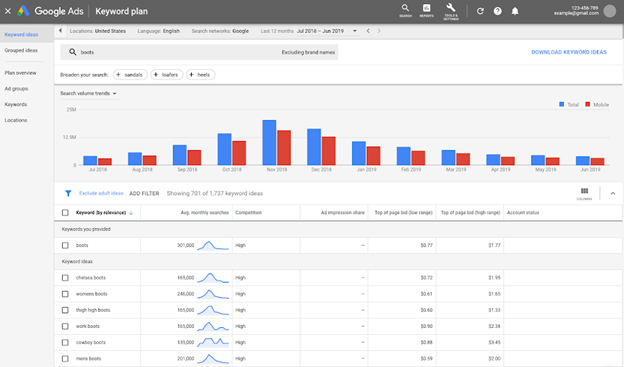
These should be the first terms you add to your list of negative keywords since Google has already demonstrated that it considers them similar to the words you chose.
Analyse Query Reports
Let your ads run for a few weeks or months, by the end of which you will receive a sizeable number of clicks and impressions. You can then run a query report to see the most common queries users typed to get SERPs containing your ad.
Suppose you see any unrelated queries inconsistent with your advertising intent, significantly higher up in the ranks. In that case, you can add them to your list of negative terms to block your ads from showing up for the phrases again.
How to Create an Ad Copy?
Now that you have the keywords done and dusted, you need a compelling, targeted ad copy to use them in. As digital marketing evolves and new tools and technologies become prevalent, creatives still need to pen down the ads displayed. You can classify PPC ads into three categories.
Expanded Text Ads
For Google and Microsoft advertising, traditional search ads were replaced by Expanded Text Ads (ETA). After creating the ad group, ETAs become helpful for any business to mark its online presence. This ad format was nearly 2x longer and was optimised for mobile devices.
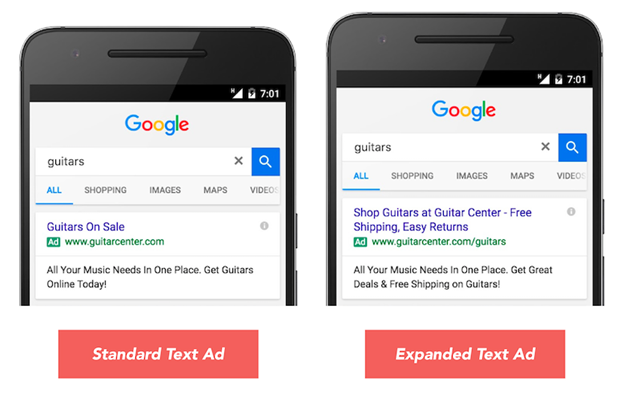
Here, you get to write two headlines of 30 characters each, followed by a description line of 80 characters.
As helpful as ETAs were, Google has now decided to retire them on June 30, 2022. But no need for panic, as your old expanded Google ads, will still be visible. However, we will advise you to try out all variations and edits beforehand.
Product Listing Ads
Do you ever search for a product on Google and see the icons with its name and price? For example, after searching ‘Samsung Phone,’ we can see the latest smartphones pop up with their cost. You will be redirected to the Samsung website’s product page on clicking the ad.
PLAs are linked to Google Merchant Center Account. Similarly, Microsoft Advertising also includes the feature of Product ads connected to Bing Merchant Center Account.
Image Ads
Display network campaigns are based on image ads and can increase response from the consumer end.
Image ads are available in various standard sizes, with 200 x 200, 240 x 400, 250 x 250, being the common ones.
How to Tackle Google Ads Click Fraud?
No doubt, Google ads help scale your business and provide you with a platform to get your ad rank higher. But one major disadvantage here is the prevalence of Google ads click fraud. Click fraud happens when an individual or group of individuals click on your ad repeatedly to make your ad campaign expensive.
It reduces your return on investment and hurts your overall marketing strategy. While some click fraud is possible in every ad platform, Google has had this problem for a long time.
Fortunately, businesses have the ability to prevent click fraud from running rampant. In the next section, we will discuss the strategies that can help you solve this issue.
Use Social Media Ads
Facebook and Twitter ads can be excellent paid advertising sources. Unlike Google ads, one can only find the ads displayed through these sources on the respective social media network. One of the most significant risks with the Google display network is its extensive network of publishers.
These publishers use ad networks on their sites and have incentives to get as many clicks as possible to increase traffic. Often publishers click on the paid ads to increase the cost per click. Even third-party competitors are known to sabotage the ad campaigns from third-party websites.
On the other hand, social media advertising is specifically linked to that social network. Click fraud is reduced in a more controlled environment.
Set Up IP Exclusions
Every user has an IP address. It is like a home address for your internet activity. You leave an IP address trail for web admins to track when visiting a site.
After the ad has been active for a while, it’s your turn to sit back and wait to see if any fraudulent patterns appear. You can generally start to see selective patterns on tracking your website visitors for a few weeks.
For example, you might spot that a specific IP address repeatedly clicks on your ad extensions. Now, you may have an obsessed fan on your hand. Good for business? Eh, not really! But it is more likely that a competitor is attempting to commit click fraud to get you to pay more.
To deal with this, visit Google ads. In the settings section under the main campaign tab, you can find the IP address exclusion box. Scroll down to the advanced section to see the IP address exclusion.
Then enter all of the fraudulent IP addresses you collected in this box. Moving forward, Google will not display your ads to these individuals.
Tweak your Ad targeting
Most click fraud incidents come down to targeting. If you are targeting an area where you see high click fraud, you might want to rethink your strategy.
Many global advertisers find that most of their fraudulent clicks come from specific countries. By excluding visitors by language and country, you can reduce ad fraud.
If you are advertising in multiple countries, do not remove all countries at once. Instead, do it one at a time. That way, you can identify the geographical region responsible for most of your challenges. In this case, you do not have to limit your paid advertising campaigns from the target audience in other nations.
Search Engine Optimisation vs. Pay-Per-Click – What to Pick?
Search engine marketing can be divided into two categories – inorganic and organic search results. You will find that marketers are often confused about what internet marketing strategy to choose. Here, we have simplified the same for you.
SEO is a gradual process requiring time, effort, and basic knowledge of what search queries to include and what search network to focus on. But as always, it is slow, steady, and relatively long-lasting.
Once you have spent enough time working on your landing page and blogs, it is hard for your competitors to get in.
On the other hand, pay-per-click is a relatively simple process where you see results instantly. Here, you pay to get listed on specific ad platforms, mostly Google SERP. Additionally, the ad space is at the top of the page to catch user attention. Effective but costly!
It is often noticed that small businesses looking to grow locally do better with SEO. But big brands or E-commerce stores will require something more practical, i.e. pay-per-click.
With SEO, you need to put up several blogs and ensure they rank high in the search engine journal. But with successful PPC campaigns, you can alter the landing pages and change them to your blog site.
But to ensure that the user clicks on the link, you need a strong blog title that complies with all search marketing guidelines. Here are a few steps to follow.
Brainstorm Titles
The process starts by thinking of different titles you can use. While you do not want to ignore the SEO basics for a blog title, you also want to create an exciting title that attracts readers.
Once you have a few ideas, you can expand this search using different keyword finder tools. For example, you can search for specific keywords based on topics that Google suggests in a search.
If you want to search for restaurants in Melbourne, you type in restaurants below and see relevant restaurant keywords like restaurants in Melbourne or restaurants near me.
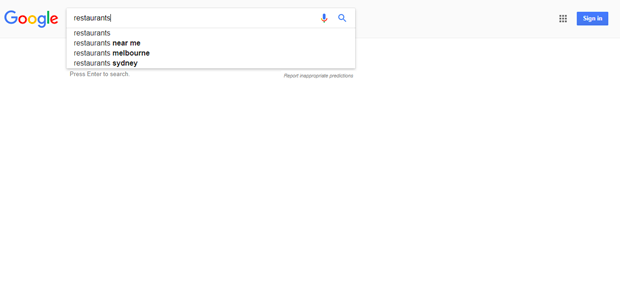
Content length
Different blog titles garner different levels of shares on various social networks. For example, between 8-12 words on Twitter gets the most shares. On Facebook, between 12-14 words receive the most likes.
The key is to find a mix that works for your audience (see buyer persona above), and then start matching that with the social networks where your audience hangs out to get the right length.
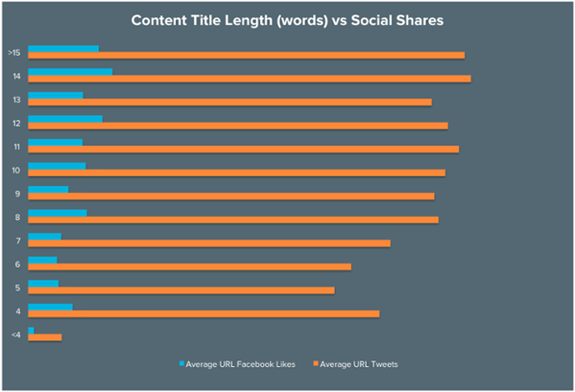
Powerful Language
Use call-to-action words that inspire readers to click on the article. Words like ‘Try’ or ‘Click’ transform your headline. It gives direction to your content, so customers know what they need to do next.
As you can see from the chart below, using negative words like ‘Never’ or ‘Worst’ can increase your click-through rate on headlines by 50%.
That is because the right words can improve the value of your headlines.
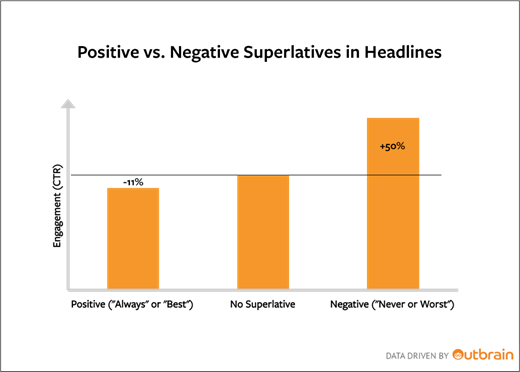
Next Step in Pay-Per-Click PPC Campaign – Google Click-to-Call
You need a new pair of shoes, so you pick up your smartphone to search for the best pair of Nike you can find in your area. One slight problem. They do not have a price listed on the website.
Fortunately, you can easily connect with the store or customer service with Google’s Click-to-Call, right from the SERP itself. You talk to a salesperson on the phone and find out they have one last pair of the design you wanted. You tell them you will be there in 30 minutes, and they put it on hold for you.
Buy Online, Pick Up at the Store (BOPIS) shopping and Google Click-to-Call are the centrepieces of the emerging shopping revolution.
In fact, a recent survey of Australian smartphone users discovered that 66% of users think it is essential to contact businesses directly from search results.
If your business wants to benefit from the BOPIS revolution, here are a few things they need to take advantage of Google’s Click-to-Call technology.
- Google My Business page
- NAP information. It is your company name, address, and corporate phone number.
- Mobile Optimisation
- Listed Business Hours
- Google Adwords
Bottomline
Pay-per-click advertising is a very vast concept. Your goal is to get listed on the top of a search engine results page and to achieve that, you run paid ads. But you also have to ensure that these ad extensions bring the desired results and take the target audience to the landing page.
The pay-per-click model can prove to be a boon for you if you ensure a quality score and comply with the guidelines laid down by the search network. In this guide, we have tried to cover some crucial ad placement tips.
So what are you waiting for? Go try these tips out and watch your ad rank rise!
If you are interested in learning more about PPC marketing for an increased conversion rate, contact our experts at Shout Digital. We provide PPC, Social Media, and SEO services in Sydney, Melbourne, and other cities in Australia.
